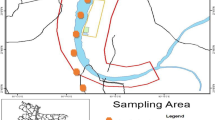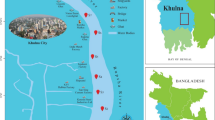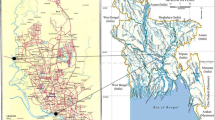Abstract
The Keenjhar Lake in the southern part of Pakistan is exposed to heavy metal contamination, mainly due to the lack of proper upstream industrial effluent treatment. In this study, accumulation of heavy metals in five frequently consumed fish species Cirrhinus mrigala (Morakhi), Labeo rohita (Kur’ro), Solea solea (Mundi), Sperata seenghala (Singharo), and Anguilla bengalensis (Baam) from Keenjhar Lake were investigated. A total of 30 fish samples were collected from fishermen at the lake. Fish tissues were digested using standard methods and analyzed for metals using an atomic absorption spectrophotometer (AAS). Heavy metal (Cu, Ni, Pb, total Cr, Cr(VI), and Cd) concentrations were detected both in fish muscles and liver. Among the five targeted species, Cirrhinus mrigala appeared to be the most bioaccumulative fish, with Cr (219.78) > Pb (34.20) > Cu (22.49) > Ni ((16.24) > Cr(VI) (15.25) > Cd (0.01). The target hazard quotient (THQ) and hazard index (HI) were calculated to assess human health risk. The concentration of metals showed a significant difference among fish muscles and liver in the three studied locations. The total HI for heavy metals were estimated to be less than 1, but the cancer risk (CR) for Pb and Cr(VI) exceeded acceptable limits for fish consumption. From the human health perspective, this study informs local populations, i.e., fishing communities and population consuming approximately 150 g/day of Keenjhar Lake fish regularly are chronically exposed to Pb and Cr(VI) contamination with (10ˉ4 to 10ˉ6) carcinogenic risks.


Similar content being viewed by others
References
Agah H, Leermakers M, Elskens M, Fatemi SMR, Baeyens W (2009) Accumulation of trace metals in the muscle and liver tissues of five fish species from the Persian Gulf. Environ Monit Assess 157(1–4):499–514
Ahmad MK, Islam S, Rahman MS, Haque MR, Islam MM (2010) Heavy metals in water, sediment and some fishes of Buriganga River, Bangladesh. Int J Environ Res 4(2):321–332
Ahmad K, Azizullah A, Shama S, Khattak MNK (2014) Determination of heavy metal contents in water, sediments, and fish tissues of Shizothorax plagiostomus in river Panjkora at Lower Dir, Khyber Pakhtunkhwa, Pakistan. Environmental Monitoring and Assessment 186(11):7357–7366
Ahmed MK, Shaheen N, Islam MS, Habibullah-al-Mamun M, Islam S, Mohiduzzaman M, Bhattacharjee L (2015a) Dietary intake of trace elements from highly consumed cultured fish (Labeo rohita, Pangasius pangasius and Oreochromis mossambicus) and human health risk implications in Bangladesh. Chemosphere 128:284–292
Ahmed T, Naqvi SMA, Abdullah S, Abbas K, Zakir S, Shah H, Zia MA (2015b) Comparative proximate body composition of wild captured and farm cultured Cirrhinus mrigala. Pak J Agric Sci 52(1):203–207
Ahmed M, Ahmad Taufiq, Liaquat M, Abbasi KS, Farid IBA, Jahangir M (2016) Tissue specific metal characterization of selected fish species in Pakistan. Environ Monit Assess 188(212):1–9
Alamdar A, Eqani SAMAS, Hanif N, Ali SM, Fasola M, Bokhari H, Katsoyiannis IA, Shen H (2017) Human exposure to trace metals and arsenic via consumption of fish from river Chenab, Pakistan and associated health risks. Chemosphere 168:1004–1012
Ali H, Khan E, Nasir MJ (2020) Bioaccumulation of some potentially toxic heavy metals in freshwater fish of river Shah Alam, Khyber Pakhtunkhwa, Pakistan. Pakistan J Zool 52(2):603–608
Ali H, Khan E (2019a) Trophic transfer, bioaccumulation, and biomagnification of non-essential hazardous heavy metals and metalloids in food chains/webs—concepts and implications for wildlife and human health. Human and Ecological Risk Assessment: An International Journal 25(6):1353–1376
Ali H, Khan E (2019b) Bioaccumulation of Cr, Ni, Cd and Pb in the economically important freshwater fish Schizothorax plagiostomus from three rivers of Malakand division, Pakistan: risk assessment for human health. Bull Environ Contam Toxicol 102(1):77–83
Ali H, Khan E (2018a) Assessment of potentially toxic heavy metals and health risk in water, sediments, and different fish species of river Kabul, Pakistan. Hum Ecol Risk Assess. Int J 24(8):2101–2118
Amirah MN, Afiza AS, Faizal WIW, Nurliyana MH, Laili S (2013) Human health risk assessment of metal contamination through consumption of fish. J Environ Pollut Hum Health 1(1):1–5
Amundsen PA, Staldvik FJ, Lukin AA, Kashulin NA, Popova OA, Reshetnikov YS (1997) Heavy metal contamination in freshwater fish from the border region between Norway and Russia. Sci Total Environ 201(3):211–224
Arulkumar A, Paramasivam S, Rajaram R (2017) Toxic heavy metals in commercially important food fishes collected from Palk Bay, Southeastern India. Mar Pollut Bull 119(1):454–459
Arnot JA, Gobas FA (2006) A review of bioconcentration factor (BCF) and bioaccumulation factor (BAF) assessments for organic chemicals in aquatic organisms. Environ Rev 14(4):257–297
Azizullah A, Khattak MNK, Richter P, Häder DP (2011) Water pollution in Pakistan and its impact on public health – a review. Environ Int 37(2):479–497
Aziz F, Azmat R, Jabeen F (2014) Water quality and pollution burden of Keenjhar Lake, Thatta Sindh, Pakistan. Int J Recent Sci Res 5(4):770–773
Chanpiwat P, Sthiannopkao S, Widmer K, Himeno S, Miyataka H, Vu NU, Tran VV (2016) Assessment of metal and bacterial contamination in cultivated fish and impact on human health for residents living in the Mekong Delta. Chemosphere 163:342–350
Datta SN, Kaur VI, Dhawan A, Jassal G (2013) Estimation of length-weight relationship and condition factor of spotted snakehead Channa punctata (Bloch) under different feeding regimes. SpringerPlus 2(1):436
Deepti S, Sharma NL (2018) Chromium pollution assessment of water in the Hindon River, India: impact of industrial effluents. Environ Conserv J 19(1&2):107–115
Emili A, Acquavita A, Covelli S, Spada L, Di Leo A, Giandomenico S, Cardellicchio N (2016) Mobility of heavy metals from polluted sediments of a semi-enclosed basin: in situ benthic chamber experiments in Taranto’s Mar Piccolo (Ionian Sea, Southern Italy). Environ Sci Pollut Res 23(13):12582–12595
EPA U (1991) Technical support document for water quality-based toxics control. EPA/505/2-90-001
FAO/WHO (2007) Evaluation of certain food additives and contaminants. Sixty-seventh report of the Joint FAO/WHO Expert Committee on Food Additives.WHO Technical Report Series 940. https://www.who.int/ipcs/publications/jecfa/reports/trs940.pdf. Accessed 13 June 2018
Farooq MA, Zubair A, Shaukat SSS, Zafar MU, Waqar A (2013) Water quality characteristics of Keenjhar Lake, Sindh Pakistan. World Appl Sci J 27(3):297–301
Food and Agriculture Organization of the United Nations (2018) FOA: [Online]. Available from: http://www.fao.org/docrep/008/v3640e/V3640E04.htm
Franco DV, Rodrigues MLK, Bavaresco J, Jardim WF (2011) A screening method for detection of hexavalent chromium levels in soils. Quim Nova 34(7):1255–1259
Giri S, Singh AK (2014) Assessment of human health risk for heavy metals in fish and shrimp collected from Subarnarekha River, India. Int J Environ Health Res 24(5):429–449
Griboff J, Wunderlin DA, Monferran MV (2017) Metals, As and Se determination by inductively coupled plasma-mass spectrometry (ICP-MS) in edible fish collected from three eutrophic reservoirs. Their consumption represents a risk for human health. Microchem J 130:236–244
Gustafsson JP, Persson I, Oromieh AG, van Schaik JW, Sjöstedt C, Kleja DB (2014) Chromium (III) complexation to natural organic matter: mechanisms and modeling. Environ Sci Technol 48(3):1753–1761
Hoffman FO, Hammonds JS (1994) Propagation of uncertainty in risk assessments: the need to distinguish between uncertainty due to lack of knowledge and uncertainty due to variability. Risk Anal 14(5):707–712
Ihedioha JN, Okoye CO, Onyechi UA (2014) Health risk assessment of zinc, chromium, and nickel from cow meat consumption in an urban Nigerian population. Int J Occup Environ Health 20(4):281–288
Iqbal J, Shah MH (2014) Study of seasonal variations and health risk assessment of heavy metals in Cyprinus carpio from Rawal Lake, Pakistan. Environ Monit Assess 186(4):2025–2037
Imran U, Ullah A, Shaikh K, Mehmood R, Saeed M (2019) Health risk assessment of the exposure of heavy metal contamination in surface water of lower Sindh, Pakistan. SN Appl Sci 1(6):589 https://doi.org/10.1007/s42452-019-0594
Imran U, Weidhaas J, Ullah A, Shaikh K (2020) Risk associated with spatio-temporal variations in trace metals and a metalloid in a major freshwater reservoir of Pakistan. An International Journal, Human and Ecological Risk Assessment, pp 1–20
Järup L (2003) Hazards of heavy metal contamination. Br Med Bull 68(1):167–182
Jhingran VG, Khan HA (1979) Synopsis of biological data on the mrigal Cirrhinus mrigala (Hamilton, 1822). FAO Fisheries Synopsis No. 120. http://www.fao.org/3/q6187e/q6187e.pdf
Khan S, Cao Q, Zheng YM, Huang YZ, Zhu YG (2008) Health risks of heavy metals in contaminated soils and food crops irrigated with wastewater in Beijing, China. Environ Pollut 152(3):686–692
Korai AL, Sahato GA, Kazi TG, Lashari KH (2008) Lead concentrations in fresh water, muscle, gill, and liver of Catla catla (Hamilton) from Keenjhar Lake. Pak J Anal Environ Chem 9(1):11–19
Korai AL, Lashari KH, Sahato GA, Kazi TG (2010) Histological lesions in gills of feral cyprinids, related to the uptake of waterborne toxicants from Keenjhar lake. Rev Fish Sci 18(2):157–176
Łuczyńska J, Paszczyk B, Łuczyński MJ (2018) Fish as a bioindicator of heavy metals pollution in aquatic ecosystem of Pluszne Lake, Poland, and risk assessment for consumer's health. Ecotoxicol Environ Saf 153:60–67
McGeer JC, Brix KV, Skeaff JM, DeForest DK, Brigham SI, Adams WJ, Green A (2003) Inverse relationship between bioconcentration factor and exposure concentration for metals: implications for hazard assessment of metals in the aquatic environment. Environmental Toxicology and Chemistry: An International Journal 22(5):1017–1037
Miri M, Akbari E, Amrane A, Jafari SJ, Eslami H, Hoseinzadeh E, Zarrabi M, Salimi J, Sayyad-Arbabi M, Taghavi M (2017) Health risk assessment of heavy metal intake due to fish consumption in the Sistan region, Iran. Environ Monit Assess 189(11):583
Mohanta MK, Salam MA, Saha AK, Hasan A, Roy AK (2010) Effects of tannery effluents on survival and histopathological changes in different organs of Channa punctatus. Asian J Exp Biol Sci 1(2):294–302
Nawab J, Khan S, Xiaoping W (2018) Ecological and health risk assessment of potentially toxic elements in the major rivers of Pakistan: general population vs. fishermen. Chemosphere 202:154–164
Qadir A, Malik RN (2011) Heavy metals in eight edible fish species from two polluted tributaries (Aik and Palkhu) of the river Chenab, Pakistan. Biol Trace Elemt Res 143(3):1524–1540
Rajeshkumar S, Liu Y, Zhang X, Ravikumar B, Bai G, Li X (2018) Studies on seasonal pollution of heavy metals in water, sediment, fish and oyster from the Meiliang Bay of Taihu Lake in China. Chemosphere 191:626–638
Shafiq HB, Ajaz M, Rasool SA (2011) Bacterial and toxic pollutants in lakes of river Indus. Pak J Bot 43(3):1765–1772
Storelli MM (2008) Potential human health risks from metals (Hg, Cd, and Pb) and polychlorinated biphenyls (PCBs) via seafood consumption: estimation of target hazard quotients (THQs) and toxic equivalents (TEQs). Food Chem Toxicol 46(8):2782–2788
Tao Y, Yuan Z, Xiaona H, Wei M (2012) Distribution and bioaccumulation of heavy metals in aquatic organisms of different trophic levels and potential health risk assessment from Taihu Lake, China. Ecotoxicol Environ Saf 81:55–64
Ullah Z, Khan H, Waseem A, Mahmood Q, Farooq U (2013) Water quality assessment of the river Kabul at Peshawar, Pakistan: industrial and urban wastewater impacts. J Water Chem Technol 35(4):170–176
US EPA. Integrated risk information system (IRIS). Washington DC: US Environmental Protection Agency; (2010). Available: http://www.epa.gov/IRIS/. Accessed 16 Apr 2018
US EPA (1989). Risk assessment guidance for superfund (RAGS): volume I - human health evaluation manual (part D), Usepa. Washington, D.C. 20450: EPA/540/1-89/002
USFDA (1993) Food and drug administration, Guidance document for nickel in shell fish.DHHS/PHS/ FDA/CFSAN/office of seafood, Washington D.C. http://www.cfsan.fda.gov/~frf/guid-as.html. Accessed 5 Aug 2018
USEPA (2011) Exposure factors handbook, 2011 edition. National Center for Environmental Assessment, Washington, DC; EPA/600/R-09/052F
World Health Organization (1976) List of maximum levels recommended for contaminants by the Joint FAO/WHO Codex Alimentarius Commission-Second series. http://agris.fao.org/agris-search/search.do?recordID=XF7703780
WHO (2011) World Health Organization. Guidelines for drinking-water quality. 4th ed. WHO Library Cataloguing-in-Publication Data. https://apublica.org/wp-content/uploads/2014/03/Guidelines-OMS-2011.pdf. Accessed 7 Jul 2018
WHO/FAO (World Health Organization/Food and Agriculture Organization) (2015) Codex Alimentarius Commission. General Standard for Contaminants and Toxins in Food and Feed, CODEX STAN 193–1995
WWF (2008) Detailed Ecological Assessment of Fauna, including Limnology Studies at Keenjhar Lake. https://foreverindus.org/ifap_sites_keenjharlake.php.
Xie W, Chen K, Zhu X, Nie X, Zheng G, Pan D, Wang S (2010) Evaluation of heavy metal contents in water and fishes collected from the waterway in Pearl River Delta in South China. J Agro-Environ Sci 29(10):1917–1923
Yi Y, Yang Z, Zhang S (2011) Ecological risk assessment of heavy metals in sediment and human health risk assessment of heavy metals in fishes in the middle and lower reaches of the Yangtze River basin. Environ Pollut 159(10):2575–2585
Yilmaz F (2009) The comparison of heavy metal concentrations (Cd, Cu, Mn, Pb, and Zn) in tissues of three economically important fish (Anguilla anguilla, Mugil cephalus and Oreochromis niloticus) inhabiting Koycegiz Lake-Mugla (Turkey). Turk J Sci Technol 4(1):7–15
Yousafzai AM, Siraj M, Habib A, Chivers DP (2012) Bioaccumulation of heavy metals in common carp: implications for human health. Pak J Zool 44(2):489–494
Yousafzai AM, Khan AR, Shakoori AR (2008) An assessment of chemical pollution in river Kabul and its possible impacts on fisheries. Pak J Zool 40(3):199–210
Acknowledgments
Authors also like to acknowledge USPCAS-W and Hi-Tech lab of Institute of Environmental Engineering & Management (IEEM), Mehran University of Engineering and Technology (MUET) Jamshoro, Sindh, Pakistan for providing laboratory facilities.
Funding information
The research funding was provided by USAID through U.S. Pakistan Centre for Advanced Studies in Water (USPCAS-W) for conducting this study under the project “Keenjhar Lake water quality assessment and valuing ecosystems services (KL-WAVES).”
Author information
Authors and Affiliations
Corresponding author
Ethics declarations
Conflict of interest
The authors declare that they have no conflict of interest.
Additional information
Responsible Editor: Philippe Garrigues
Publisher’s note
Springer Nature remains neutral with regard to jurisdictional claims in published maps and institutional affiliations.
Rights and permissions
About this article
Cite this article
Mehmood, R., Imran, U., Ullah, A. et al. Health risks associated with accumulation of heavy metals in fish of Keenjhar Lake, Pakistan. Environ Sci Pollut Res 27, 24162–24172 (2020). https://doi.org/10.1007/s11356-020-08705-4
Received:
Accepted:
Published:
Issue Date:
DOI: https://doi.org/10.1007/s11356-020-08705-4




